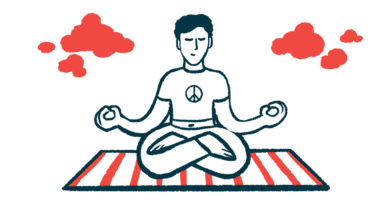Tai Chi Improves Motor Function in Early-stage Parkinson’s: Study

Practicing tai chi for a year improved gait and balance in early-stage Parkinson’s disease patients, improving both inflammation and metabolism as well as brain function, according to a recent study.
The study, “Mechanisms of motor symptom improvement by long-term Tai Chi training in Parkinson’s disease patients,” was published in Translational Neurodegeneration.
Tai chi combines continuous and gentle body movements with breathing control to improve muscle strength, balance, and motor control. Clinical evidence has suggested that practicing it for six months can reduce motor symptoms and improve quality of life for those with Parkinson’s disease.
However, due to the progressive nature of Parkinson’s, it’s not known if there are any long-term therapeutic benefits to practicing it.
A team led by researchers in China conducted a clinical trial to assess the long-term effects — over one year — of tai chi training on Parkinson’s motor symptoms. The trial was done as part of a philanthropic project called “Tai Chi Adjuvant Therapy for Parkinson’s Disease,” jointly launched by Fosun Foundation, Sino Taiji and the Neurology Department of Ruijin Hospital.
The project has provided free courses for 445 patients with Parkinson’s disease and will continue to carry out charitable tai chi courses for Parkinson’s patients across China.
In total, 95 patients with early-stage Parkinson’s were randomly assigned to one of three groups — a tai chi group (32 patients, mean age 62.7 years), a brisk walking group (31 patients, mean age 61.9 years) and a non-exercise group that served as a control (32 patients, mean age 61.9 years).
Motor symptoms were evaluated at the trial’s start (baseline), and then again at six and 12 months using the Berg Balance Scale (BBS), the Unified Parkinson’s disease rating scale (UPDRS), the Time Up and Go test (TUG) and spatial 3D gait (walking) analysis.
The TUG test evaluates the time taken to stand up from an armchair, walk three meters, turn, walk back, and sit down.
The six-month and 12-month follow ups were completed by 66 patients.
The results showed that, compared to the control group, patients in the tai chi group showed significant improvements in balance at six and 12 months of follow-up. It also was better than brisk walking at improving balance.
Compared to controls, those who practiced tai chi showed significantly greater improvements in UPDRS scores after one year and in the TUG test at both follow-ups.
Significant improvements in step width were also observed at both follow-ups in those who practiced tai chi, compared to controls.
The tai chi group also showed greater improvements in step width, when compared to brisk walking.
Improved balance was correlated with enhanced visual network function and lower levels of interleukin-1-beta, a pro-inflammatory molecule. Improvements in motor scores were associated with enhanced default mode network function, a group of regions in the brain that are preferentially active “at rest” or not engaged in a specific mental task.
Along with lower levels of several inflammatory molecules, tai chi also led to a drop in different metabolites, including L-arginine, known for its role in oxidative stress. Metabolites are intermediate or end products, such as amino acids, organic acids, sugars, or lipids, that take part in or are produced as part of cellular metabolism.
Oxidative stress, which is marked by the imbalance between producing and clearing toxic reactive species that are harmful to cells, is thought to play a key role in neurodegenerative diseases like Parkinson’s.
Overall, tai chi altered the levels of several metabolites that were found to be related to changes in UPDRS scores.
It also resulted in increased levels of HIP2, an enzyme that’s been linked to neurodenegeration, which showed a tendency to be reduced in the control group. A previous study has found that lower levels of this enzyme cause motor function impairment in models of Parkinson’s disease.
The findings suggest that “long-term Tai Chi training improves motor function, especially gait and balance, in PD patients,” the researchers wrote. “Enhanced brain network function, reduced inflammation, improved amino acid metabolism, energy metabolism and neurotransmitter metabolism, as well as decreased vulnerability to dopaminergic degeneration may be mechanisms underlying the effects of Tai Chi training.”
A separate study led by the same research team suggests tai chi training can delay the progression into Alzheimer’s disease in people with mild cognitive impairment, a known disease risk factor.







